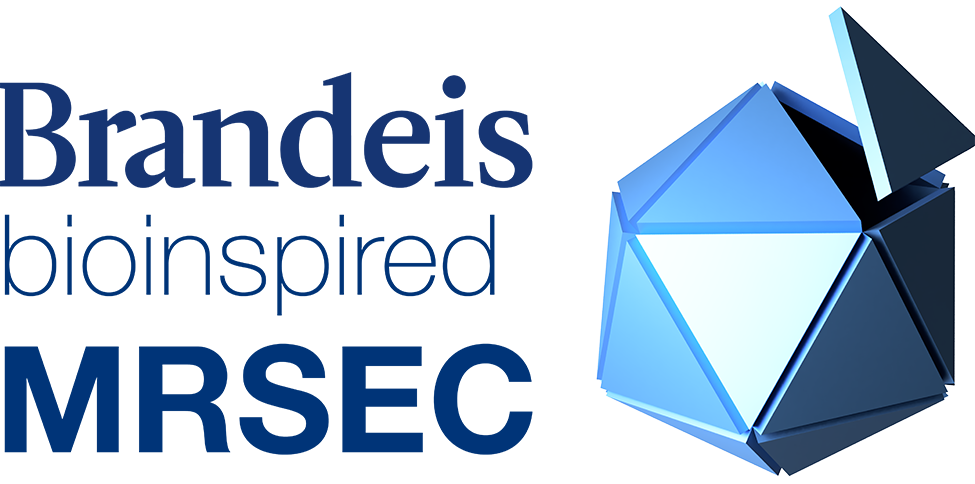Highlights
Highlights of IRG research are reported on an ongoing basis to the NSF MRSEC program. Publications supported by Brandeis MRSEC funding are recorded here.
2024
As first suggested by Caspar and Klug, many viruses assemble icosahedral shells (capsids) because the high symmetry of the icosahedron enables economical assembly—enclosing a large volume with relatively few distinct protein subunit types. A collaboration between Grason, Hagan, and Santangelo generalize this design principle to triply-periodic polyhedra, mesoporous structures approximating cubic minimal surfaces. They demonstrate the programmable assembly of various minimal surfaces from a minimal number of distinct subunits forming arbitrarily large unit cells of tunable, defined size. However, while high symmetry points enable economy in these target structures, they can also serve as seeds of misassembly. This design strategy, and the fundamental tradeoff between economy and fidelity, lays the groundwork for deploying rapidly advancing nanotechnology approaches to programmable assembly to achieve size-controlled architectures with tunable functional properties.
Triangular monomers with positive Gaussian curvature and specific interactions assemble into a self-closing icosahedral capsid containing 60 subunits. Brownian Dynamics computer simulations show that the capsid yield is controlled by a balance between the binding strengths of the two specific interactions—one between red and blue edges, and one between white edges. Two specific combinations of the binding energies lead to a dramatic enhancement in the yield, which correspond to two hierarchical pathways: one in which dimers form first and then 30 dimers assemble into the capsid, and one in which pentamers form first and then 12 pentamers assemble into the capsid. These simulations motivate a detailed experimental study of the assembly of synthetic capsids from nanometer-scale subunits made using DNA origami.
Active nematics are attracting significant attention due to their rich emergent dynamics, which have potential applications in robotics, drug delivery, and materials science. The director field, which measures the direction and degree of alignment of the local nematic orientation, is a crucial characteristic of active nematics and is essential for studying topological defects. However, determining the director field robustly from experimental data is often challenging. We developed a machine learning model for extracting reliable director fields from experimental images of 2D active nematics, enabling accurate topological defects analysis. The approach is robust and highly generalizable to experimental settings different from those in the training data. This machine-learning approach is a promising tool for investigating active nematics and may be generalized to other active matter systems.
Self-organization in living cells is often driven by energy-consuming motor proteins that push and pull on a network of cytoskeletal filaments. However, it is unclear how to connect the emergent structure and dynamics of reconstituted cytoskeletal materials to the kinetics and mechanics of their microscopic building blocks. We systematically correlate bulk structure with asymmetry of the motor distribution along single filaments to explain the transition from extensile bundles to contractile asters in active networks of microtubules crosslinked by motor proteins. We combine experiments and theory to identify a single parameter that predicts how the system will self-organize. This work shows that biochemical and mechanical interactions compete to set the emergent structure of active biomimetic gels. The Center will exploit these results to build autonomous soft materials with lifelike attributes
In Fall 2023, the Brandeis MRSEC, in partnership with the University of Delaware MRSEC, developed and executed a workshop series aimed at supporting trainees interested in pursuing industry positions after completing their PhDs and postdoctoral fellowships.
The three-part series was delivered virtually and addressed the topics “How to Dissect a Job Listing,” ”How to Make Connections,” and ”How to Be the Full Package.” In “How to Dissect a Job Listing,” attendees learned how to determine what prospective industry employers are seeking in candidates and how to assess if a trainee’s skill set is a match. In ”How to Make Connections,” attendees engaged with a panel of MRSEC alumni who are employed in early-career industry positions. Conversation centered around finding that first industry position and successfully transitioning from academia to industry. In “How to Be the Full Package,” attendees learned how to navigate the application and interview process and how to negotiate a competitive compensation package.
This workshop series was developed in response to trainee feedback requesting guidance on pursuing industry positions and drew 50 attendees. This series will continue, including an industry panel scheduled for Fall 2024 which will be advertised to trainees across all MRSECs.
The Brandeis MRSEC has provided mentorship to the Brandeis undergraduate organization Brandeis Encourages Women in Science and Engineering (BeWiSE) since 2020. BeWiSE is a student organization that promotes and supports female Brandeis undergraduate students interested in science and engineering through community youth outreach. Since 2022, BeWiSE has partnered with MRSEC to successfully run an outreach series which include hands-on, open-ended design competitions and panel discussions focused on college applications and admissions and pursuing STEM undergraduate degrees.
An integral piece of the mentorship provided by the MRSEC was to work with BeWiSE in a way to ensure the organization was able to provide ongoing high-quality engagement to K12 students. Rather than simply organizing the event on BeWiSE’s behalf, MRSEC worked with the high school and student organization to establish a relationship that can continue and train undergraduate students on providing engaging, age-appropriate activities while scaling panel discussions to be relevant and interesting to the audience.
During this outreach series, BeWiSE engaged with over 130 Waltham High School students with plans to expand engagement in upcoming years.

